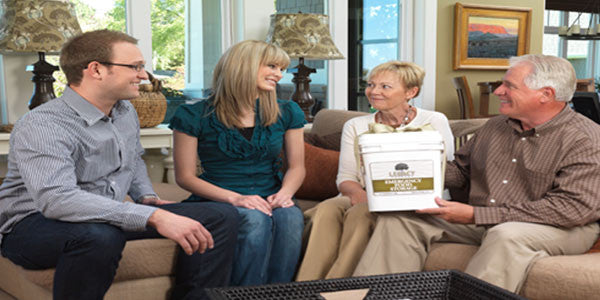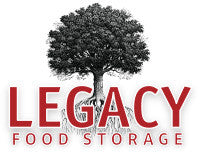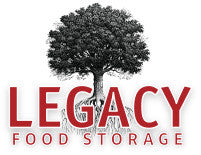
Preparing the Family for 2014: Five Essentials for the Inevitable Emergency
 By Phil Cox, CEO, Legacy Food Storage
By Phil Cox, CEO, Legacy Food Storage
From food shortages and natural disasters to political unrest and economic uncertainty, the world is not a predictable place. A National Geographic Channel survey conducted in 2012 found that even though 64 percent of Americans surveyed thought the U.S. would experience a significant earthquake or other major emergency state within the next 25 years, a staggering 25 percent said they have done nothing to prepare for it. Not good.
For many people, this inactivity is due in large part to a lack of knowledge about how exactly to get started. To help you take the first step, here are some basic emergency preparedness steps you can take to get you and your family ready for whatever comes:
Stock up on Food
Results from the National Geographic survey highlight another disturbing fact about Americans and their food storage. If a major natural disaster or emergency situation were to interrupt the current flow of resources, 18 percent of Americans say they wouldn’t be able to last two weeks on the supplies they currently have in their homes.
Again, this may be due to a lack of knowledge about how to get started, but it may also be because people believe storing food can be expensive. The truth? Storing food is not as overwhelming as it seems.
First, add it into your budget. No matter how tight things are, most people can afford to spare $10 or $20 or even $50 a month. Dedicate whatever amount to your emergency food storage. Buy what you can when foods go on sale, or put your money toward a bigger purchase of emergency food from a reputable food storage company that offers food with a very long shelf life. (Some offer 25-30 years.)
Keep these things in mind as you gather emergency food:
1. Store food you regularly eat.
2. Store food that tastes good.
3. Store a variety of foods.
4. Store food that has a long shelf life.
5. Store freeze-dried meals that only require boiled water (and a heat source to boil it)
5. Store an alternative way to cook your food should power go out. (Think camp stoves, dutch ovens, and the like.)
Our family of six keeps a 3-month supply of long-term emergency food storage in buckets (with mylar pouch food storage instead of cans. They stack better). In our pantry, we also keep a lot of additional canned items, as well as peanut butter, crackers and other items that can keep for 3+ months and then rotate them throughout the year.
Store Water
FEMA recommends starting with storing one gallon of water per person per day for at least three days. This is a very meager amount when the realities of an emergency situation hit, so store more if you can. You can never have too much water. My family keeps water bottles stored throughout the home, along with a 50-gallon water drum in the garage, which we then rotate every six months.
How to Store Water Safely
1. Store water in food-grade containers (but not juice or milk cartons, as the sugar will have created bacteria growth).
2. Store water only in containers that have been thoroughly sanitized first.
3. Store water away from heat and light.
4. Rotate self-bottled water out every six months and store-bottled water out every 12 months.
In addition to storing water, it’s also a good idea to store water purification tools. There are a variety of convenient and inexpensive water purification systems, from water bottles with built-in filter straws to gallon-size water pitchers. Other options are to use water purification tablets, apply the bleach method (16 drops of regular household bleach added to a gallon of water), or simply to boil water vigorously for 1-2 minutes. All of these methods should purify most types of contaminated water.
Put Away Fuel
Fuel is essential in emergency situations for heating, cooking meals and powering tools, generators and household appliances. There are a variety of fuel types to choose from, some more difficult to store than others. Gasoline, for example, must be stored according to strict regulations depending on your area and has a relatively short shelf life. Propane lasts for long periods of time but is fairly expensive to buy in large amounts. More traditional fuel sources like kerosene or firewood can be good options but require a little more knowledge and creativity. Many people (including our family) finds it convenient to store quick-lighting fuel discs or fuel cans to use along with their camping stoves, and these can be purchased through some emergency food companies or outdoor suppliers. Some only burn for 20 minutes; others will burn for up to 4 hours per cell, so do your homework well in advance to decide which type of fuel will work best for you (and your budget) – and stock up.
Gather Emergency Kits
FEMA offers a detailed list of basic emergency supplies, including practical items like batteries, flashlights, first aid supplies and other emergency essentials. Ideally, everyone should have a comprehensive emergency supply kit that stays at home with their other emergency items, a kit that is more portable for taking with them if evacuation becomes necessary, and smaller supply kits in the trunks of their cars, in school backpacks, and in work desks so that emergency supplies are available even if disaster strikes when not at home, which it often the case.
My wife has prepared 72-hour packs for each member of our family. We keep them above the washer and dryer in our laundry room. Each bag has a water filter, change of clothing, flashlights, food, emergency kits (band aids, stuff like that, etc), and a few other essentials.
Make a Family Emergency Plan
The Ad Council’s 2013 national survey found that 60 percent of Americans surveyed do not have a family emergency plan. This plan will help eliminate stress during an emergency, and should include specific procedures each family member will follow in case it happens when you are apart.
First, decide how you will contact one another to let each other know that you are safe and where you will be:
- Designating an out-of-state family member that everyone should call
- Use the Red Cross’s Safe and Well website
- Post status updates on social media.
Also, discuss how you will reunite when the disaster is over. Designate meeting places in your neighborhood, outside your neighborhood, and out of town, and make sure everyone is clear about when to meet where.
In addition, try to keep your car tanks at least half full of gas at all times because you might not be able to refill during an emergency.
Summing It All Up for Real Life
Preparation is not about paranoia or hypothetical situations; it’s about doing all you reasonably can to protect yourself and your family from situations that occur regularly across the world. Once you have your emergency preparations finished, you’ll know you’ve done all you can to keep your family safe.
What have you done to prepare your family for an emergency?
The post Preparing the Family for 2014: Five Essentials for the Inevitable Emergency appeared first on Buy Emergency Food.
Tags
- All
- 25 year food
- 25 year shelf life food
- 72 hour kit
- Best food storage types
- Best long-term food storage
- Blizzard preparedness
- Budgeting
- canning
- Certified GMO-free Emergency foods
- Certified GMO-free foods
- Coffee
- Comparison of emergency food methods
- Composting tips
- Dangers of genetically modified foods
- dehydrated food
- Edible Wild Plants
- emergcy preparedness
- Emergency Cooking
- Emergency Food
- Emergency food Christmas gifts
- emergency food storage
- Emergency Food Supply
- Emergency food supply recommendations
- Emergency Planning
- Emergency Preparedness
- Emergency preparedness advice
- emergency preparednesss
- Emergency Supplies
- Emergency supplies checklist
- Emergency Survival
- emergency survival gear
- Emergency survival kit checklist
- Emergency Survival skills
- exercise
- Family emergency preparedness
- Family emergency preparedness plan
- Family Preparedness
- Food Storage
- Food storage 25 year shelf life
- Food storage amounts
- Food storage Christmas
- Food storage containers long term
- Food Storage Secrets
- Food storage serving size
- Food storage types compared
- freeze dried food
- Freeze dried food storage
- freeze dried meats
- Freeze-dried emergency food storage
- Fruit Trees
- Gardening
- Getting Started
- Gluten-free food Storage
- Gourmet emergency food
- Healthy food storage
- How much emergency food to store
- Improved emergency preparedness
- Jared Markin
- Jared Matkin
- Legacy Premium
- Lessons learned from Hurricane Sandy
- Lessons learned from natural disasters
- long-term food storage
- Long-term Food Storage Guidelines
- Long-term Food Storage tips
- Long-term water storage
- Mental Emergency Preparedness
- Mental toughness
- Money-saving tips
- Natural disaster planning
- Natural Disasters
- Perfect Christmas gifts
- Pet Emergency preparedness checklist
- Pet Emergency preparedness kit
- Pet Emergency Survival tips
- Pets and Emergency Preparedness
- Plant Foraging
- portable solar panels
- portable solar power
- portable water filters
- protein drinks
- Risk of genetic modification
- Seed saving and storage
- Seed saving guide
- Self-reliance
- Self-reliant practices
- Shelf Life
- Solar Cooking
- Solar Ovens
- Special Dietary needs
- Stranded in a car in a blizzard
- Survival food
- Survival Gear
- survival kit
- Survival kits
- Survival Ovens
- Survival Skills
- survivalist gear
- suvival kit
- Tree Pruning tips
- Tree Trimming basics
- unique ideas
- water bottle with filter
- water filter
- water filter straw
- water filters
- Water Filtration
- water pitcher with filter
- water pitchers with filters
- Water purification
- Wild Food Foraging
- Winter composting
- Winter driving
- Winter preparedness tips
- Winter storm preparedness tips
- Winter Survival







